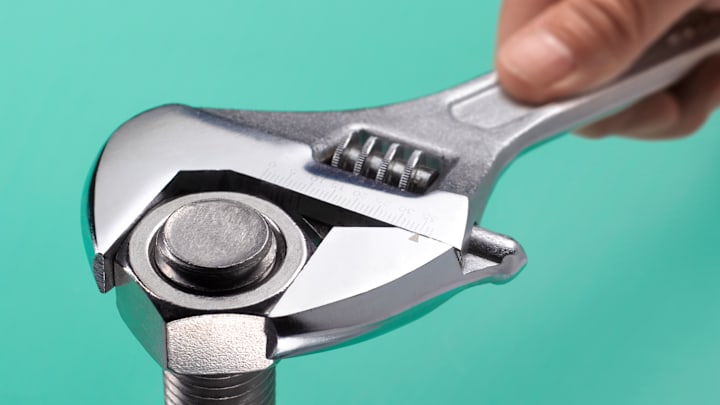If you’ve ever embarked on any home improvement projects or tinkered on a car, you’ve probably picked up an adjustable wrench. The gripping tool can easily be resized by a wheel maneuverable with your thumb. Yet you’ve probably never asked for it by that name. That’s because the adjustable wrench is far more well-known by its other moniker: the crescent wrench. And while it might seem like the name is a nod to the crescent-shaped jaw of the tool, that’s not the entire story.
The crescent wrench is actually the Crescent wrench. It’s not a colloquial term but a brand name for an adjustable wrench invented by Swedish immigrant Karl Peterson and brought to market in the early 1900s. Peterson’s innovation was a simple one: Rather than force mechanics to harbor a complete set of wrenches in different sizes, the Crescent allowed them to quickly adjust the width of the wrench, creating a perfectly-suited tool regardless of the nut, bolt, or other fastener they were securing. (One jaw is fixed; the other can be moved inwardly or outwardly with the thumb wheel to change the width.)
Peterson originally opened his business in Jamestown, New York, in 1907, with a focus on standard pliers. But when Peterson received a visitor from Sweden who reminded him of an adjustable wrench popular in that country, he began to consider the possibilities. (While the Crescent is the most well-known of its type, it was not the first: Adjustable wrenches of various designs date to the 1800s, though most invited frustration when the moving jaw got stuck.)

By 1910, the wrench was being advertised in newspapers. Peterson applied for and received a patent in 1915, which was accompanied by the following explanation: “the invention relates to improvements on adjustable jaw wrenches for bolt nuts; and the object of the invention is to provide a simple adjustable jaw wrench of great strength which [fits] the faces of a hexagonal nut as well as a square nut and also has a positive adjustment which is not changed by the dropping of the wrench.”
As no one took exhaustive notes of the tool’s genesis, the origin is the subject of some debate. Another version of the story has Peterson acquiring the invention from a man named Gunnard Oberg for $500. In either case, because the jaws looked like a crescent moon, Peterson named it the Crescent wrench.
The tool quickly earned the respect of tinkerers, professionals, and luminaries. In 1927, aviator Charles Lindbergh offered a priceless plug for the wrench when, after completing his transatlantic solo flight, he rattled off a list of his indispensable items that he carried even though he was trying to keep the weight of the aircraft down: “gasoline, sandwiches, a bottle of water, and a Crescent wrench and pliers.”
Lindbergh wasn’t the only one to take flight with the wrench: Balloonist A.W. Stevens carried one with him during a record altitude hot air balloon trip in 1935. And in 1965, astronauts Gus Grissom and John Young took some of the wrenches with them on the Gemini mission into space. (Peterson wasn’t around to see the latter two milestones: he died in 1933 at age 67.)
The ubiquity of the name became a problem in 1931, when Crescent Tool Company sought and received an injunction against retailer Montgomery Ward for advertising a “crescent wrench,” arguing it would mislead consumers. At that point, Crescent Tool claimed to have sold 18 million of the wrenches.
It’s harder to find such copycat wrenches today: A cursory look at tools on Amazon or via Home Depot reveal that searching for a “crescent wrench” brings up adjustable wrenches that avoid using the word crescent, meaning that Crescent (the brand) remains protective of the name.
While the Crescent wrench was a considerable leap forward in the tool world, it does come with a caveat. The biggest disadvantage is that the adjustable jaw isn’t as strong as a wrench that’s fixed in place. Heavy-duty industrial workers, for example, might opt for a fixed wrench due to its durability and high torque.
Crescent is currently owned by Apex Tool Group. And while the term is still trademarked, it’s easy to think of any adjustable wrench as a Crescent just like we refer to most facial tissues as Kleenex. In both cases, the marketing was a little too effective.
Get Answers to More Big Questions:
Correction 09/25/24: An earlier version of this article incorrectly stated the Crescent adjustable wrench was included in a tool kit for the Ford Model T car.
